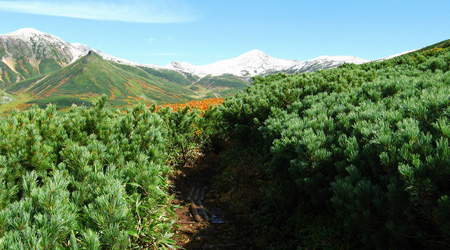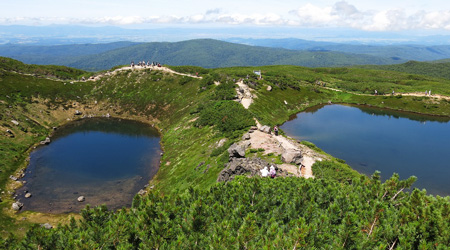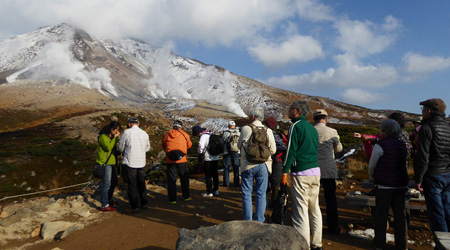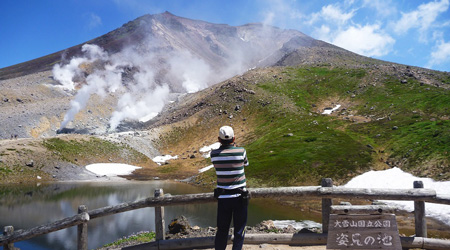Walking takes 2 and half hours to Sugatami Station, the starting point of the course, but this time we will use the ropeway from Asahidake Station. From the ropeway, we can see the forests at the foot of Mt. Asahidake. It’s fascinating to see the tree crowns from the top. Although we can see only trees, the colors are not uniform. Various shades of green create something akin to a patchwork. The beauty of this patchwork takes half a year to complete and reaches its stunning glory in the autumn with its explosion of red and gold colored leaves. As we rise in altitude from the mixture of conifer and broadleaf trees, the vegetation distribution changes to a coniferous forest of dark green. Upon closer inspection we can see that there are two kinds of trees. These are Sakhalin fir and Ezo spruce.
Which trees have an image of a Christmas tree? People from Europe point to the Ezo spruce while those from the American continent point to the Sakhalin fir. This is because on the Eurasian continent spruce mainly grows, while on the American continent fir is dominant. But here, both kinds are mixed and living together. We live in such a rich environment that we can choose either spruce or fir for Christmas trees.
After we get off the ropeway at Sugatami Station, we take in lectures from a ranger regarding the natural environment for the season, wild animals such as brown bears, and things to be aware of when using the facilities. After the lectures, we start walking. When we go out of the station building, we encounter a snowy valley even in midsummer. This abundant snow is also one of the characteristics of the Daisetsu mountains and one of the factors in the creation of “The Garden of the Gods”. You can go around from either direction, but keep to the left while walking to allow others to pass easily. Watch your step when it is crowded.
After we climb up a little, we get to the No.1 Observation Platform. Strong wind is blowing up from the west. Because there is always a strong wind blowing, it is a world with rugged stones and gravel. In winter, little snow accumulates, developing a permanently frozen ground underneath from temperatures that are lower than minus 30 degrees centigrade. Even in such a harsh environment, we can find small plants which bloom, such as Minezuou, Komemba-tsugazakura and Japanese crowberry. Small shrub trees grow close together in order to protect themselves against drying out. This environment, which is close to the limits of where plants can grow, reminds one of the lands in the Arctic Circle. One wonders whether these plants have come from the Arctic, too.
We go down from the observation platform and through the flower fields of Iwaume and Takane-sumire, which are resistant to drying out. Along the road to the No.2 Observation Platform, we can see short pine trees and dwarf stone pine trees are densely growing. The back slope of the No.1 Observation Platform has a hollow, where winds are slightly weaker and snow accumulates in winter. The snow becomes a thermal insulating material, which allows plants to survive the severe winter. We can clearly see this from the fact that along this dwarf stone pine road, the upwind areas, where the snowfall has not accumulated much, the height of the dwarf stone pines is low, whereas the downwind area where snowfall has accumulated a lot, the trees are higher. However, in areas where there is too much snow, the trees won’t be able to grow much in summer. We can find lingonberry and Urajiro-mountain ash, which are strong against drying out, in the areas of low snow accumulation, and the dry ground under the trees. In these dry areas, there are a lot of plants which originated in eastern Siberia.
Vegetation changes a lot due to slight changes in the terrain, which makes us feel like we are travelling from the Arctic regions to eastern Siberia in only a few hundred meters.
Below us, we can see the high altitude wetlands with ponds of dark blue water surrounded by green—just beautiful. In ten minutes, we pass the No. 3 Observation Platform and reach Kagami Pond and Suribachi Pond. These were created by volcanic activity, and water filled the craters. As these ponds are sitting side by side, they are known as the “Husband and Wife Ponds”.
Continuing on, we can see Kagami Pond on the left. Walking along the road, we enjoy the antics of the Ezo squirrels as we reach the No.4 Observation Platform and its wide-open views. Behind us is the majestic shape of Mt. Asahidake, with volcanic gas and steam spewing snow-white smoke. In front of us, we can see the ponds we just passed. Further on we can see the striped patterns formed by the snowfields interspersed with strips of alpine plants and flowers at the places where the snow has melted away. The dwarf stone pines and the rocky ground stand out in the exposed areas. In the distance, the cities and towns lay far below the clouds. Volcanoes, wind, snow, and various flowers come together here in perfect harmony to create a beautiful garden — a natural botanical garden where you can feel like you are in the Arctic, Siberia, and Kamchatka.
When the sounds from the crater become their loudest, we are at Sugatami Pond. We turn left and after passing a stone emergency shelter, we get to a long downhill slope.
After descending a ways, we encounter the snowfields interspersed with the strips of blooming flowers which we saw from the No.4 Observation Platform. A small stream flows out from the snowy gorge, and provides the moisture to create greenery and blooming flowers. The view is totally different from the one in the area of the gravel on the west slope continuing from the No. 1 Observation Platform. If we were to see a brown bear here, the area might be mistaken for Kamchatka or Alaska. We have moved from Far East Siberia to Kamchatka then across the North Pacific to the American Northwest. Blue mountain heath and Ezono-kozakura found this environment which resembles their ancient home, and here, at the end of their long journey, form big communities.
You can find a light, cream-colored road there. False helleborine flowers bloom quickly to take advantage of the moisture from the melting snow and follow the trace of the riverbed. In autumn, this road changes to the purple color of the Ezo-oyama-rindou. The slight difference in height between the riverbed and the high natural levee also has an effect on the flora along it. Along the riverbed, Ezo-kozakura lives. Along the levee, Aleutian avens appear. The severe weather conditions of the Daisetsu highlands creates a diversity of life and color in the short, transient green season by the different plants fitting themselves into their own small niches caused by small changes in the topography.
Located at the center of an island wedged between the continents, with its rich bio-diversity of hardy, adaptable life shaped by the otherworldly volcanic terrain of this plateau that has created this beautiful miracle known as the “Garden of the God’s“.
On your way back, you can use the ropeway, or enjoy walking to another high-altitude wetland with its characteristic ecosystem at Tennyo-gahara.










